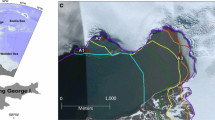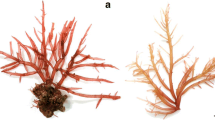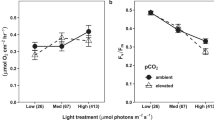Abstract
Photosynthetic characteristics of the red macroalgae Phyllophora antarctica and Phymatolithon foecundum collected from under sea ice at Cape Evans, McMurdo Sound (Ross Sea) were determined using in situ fluorometric and lab-based oxygen exchange techniques. Only 0.16% of incident irradiance penetrated the 2.5 m thick ice cover and photosynthetic parameters for both taxa were characteristic of highly shade-adapted plants. Saturation onset parameter (E k) did not exceed 13 μmol photons m-2 s-1 in either taxon. For Phyllophora antarctica the light saturated photosynthetic rate at –1°C was 10 μmol O2 g-1 FW h-1 and respiration averaged 3.3 μmol O2 g-1 FW h-1 between sampled depths of 10 and 25 m. A light meter deployed at 15 m depth for a year recorded a marked increase in underwater irradiance on the last day of January 2002 coinciding with ice-breakout, and a maximum value for irradiance of 120 μmol photons m-2 s-1 on 9 February 2002. The 2-month ice-free period was the only time when irradiance consistently exceeded compensation (photosynthesis=respiration) and enabled Phyllophora antarctica to accumulate sufficient carbon to result in a measurable increase in thallus area equivalent to a biomass increment of 1.87 mg (DW) per frond. Near the southern global limit for marine macroalgae, conditions that dictate the availability of underwater irradiance are extremely variable from year to year. Low respiration rates enhance longevity of the Phyllophora antarctica thallus, enabling it to not only survive the winter darkness, but also to retain photosynthetic capacity and thus take advantage of windows of higher irradiance.






Similar content being viewed by others
References
Alongi G, Cormaci M, Furnari G (2002) The Corallinaceae (Rhodophyta) from the Ross Sea (Antarctica): a taxonomic revision rejects all records except Phymatolithon foecundum. Phycologia 41:140–146
Amsler CD, McClintock JB, Baker BJ (1999) An Antarctic feeding triangle: defensive interactions between macroalgae, sea urchins and sea anemones Mar Ecol Prog Ser 183:105–114
Beer S, Björk M (2000) Measuring rates of photosynthesis of two tropical seagrasses by pulse amplitude modulated (PAM) fluorometry. Aquat Bot 66:69–76
Beer S, Vilenkin B, Weil A, Veste M, Susel L, Eshel A (1998) Measuring photosynthetic rates in seagrasses by pulse amplitude modulated (PAM) fluorometry. Mar Ecol Prog Ser 174:293–300
Bischoff-Bäsmann B, Wiencke C (1996) Temperature requirements for growth and survival of Antarctic rhodophyta. J Phycol 32:525–535
Cormaci M, Furnari G, Scammacca B, Alongi G, Catra M (1998) Summer biomass of a population of Phyllophora antarctica (Phyllophoraceae, Rhodophyta) from Antarctica. Hydrobiologia 362:85–91
Cormaci M, Furnari, G, Scammacca B (1992) The benthic algal flora of Terra Nova Bay (Ross Sea, Antarctica) Bot Mar 35:541–552
Dayton PK (1990) Polar benthos. In: Polar oceanography. Part B. Chemistry, biology and geology. Academic, San Diego, pp 631–686
Drew EA, Hastings RM (1992) A year-round ecophysiological study of Himantothallus grandifolius (Desmarestiales, Phaeophyta) at Signy Island, Antarctica. Phycologia 31:262–77
Dunton KH (2001) δ15N and δ13C measurements of Antarctic Peninsula fauna: trophic relationships and assimilation of benthic seaweeds. Am Zool 41:99–112
Gambi MC, Buia MC, Mazzella L, Lorenti M, Scipione MB (2000) Spatio-temporal variability in the structure of benthic populations in a physically controlled system off Terra Nova Bay: the shallow hard bottoms. In: Faranda FM, Guglielmo L, Ianora A (eds) Ross Sea ecology. Springer, Berlin Heidelberg New York, pp 527–538
Gómez I, Wiencke C (1998) Seasonal changes in C, N and major organic compounds and their significance to morpho-functional processes in the endemic Antarctic brown alga Ascoseira mirabilis. Polar Biol 19:115–124
Gutkowski R, Maleszewski S (1989) Seasonal changes of the photosynthetic capacity of the Antarctic macroalga Adenocystis utricularis (Bory) Skottsberg. Polar Biol 10:145–148
Hanelt D, Jaramillo JM, Nultsch W, Senger S, Westermeier R (1994) Photoinhibition as a regulative mechanism of photosynthesis in marine algae of Antarctica. Ser Cient 44:67–77
Hanelt D, Uhrmacher S, Nultsch W (1995) The effect of photoinhibition on photosynthetic oxygen production in the brown alga Dictyota dichotoma. Bot Acta 108:99–105
Hawes I, Schwarz A (2001) Absorption and utilization of irradiance by cyanobacterial mats in two ice-covered Antarctic lakes with contrasting light climates. J Phycol 37:5−15
Henley WJ (1993) Measurement and interpretation of photosynthetic light-response curves in algae in the context of photoinhibition and diel changes. J Phycol 29:729–739
Jassby AD, Platt T (1976) Mathematical formulation of the relationship between photosynthesis and light for phytoplankton. Limnol Oceanogr 21:540–547
Kirk JTO (1994) Light and photosynthesis in aquatic ecosystems. 2nd edn. Cambridge University Press, Cambridge, p 509
Kirst GO, Wiencke C (1995) Ecophysiology of polar algae. J Phycol 31:181–199
Kühl M, Glud RN, Borum J, Roberts R, Rysgaard S (2001) Photosynthetic performance of surface-associated algae below sea-ice as measured with a pulse-amplitude-modulated (PAM) fluorometer and O2 microsensors. Mar Ecol Prog Ser 223:1–14
Lüder UH, Wiencke C, Knoetzel J (2002) Acclimation of photosynthesis and pigments during and after six months of darkness in Palmaria decipiens (Rhodophyta): a study to simulate Antarctic winter sea ice cover. J Phycol 38:904–913
Miller KA, Pearse JS (1991) Ecological studies of seaweeds in McMurdo Sound, Antarctica. Am Zool 31:35–48
Reichardt W, Dieckmann G (1985) Kinetics and trophic role of bacterial degradation of macro-algae in Antarctic coastal waters. In: Siegfried WR, Condy PR, Laws RM (eds) Antarctic nutrient cycles and food webs. Springer, Berlin Heidelberg New York, pp 115–122
Schreiber U, Schliwa U, Bilger W (1986) Continuous recording of photochemical and non-photochemical chlorophyll fluorescence quenching with a new type of modulation fluorometer. Photosynth Res 10:51–62
Seely GR, Duncan MJ, Vidaver WE (1972) Preparative and analytical extraction of pigments from brown algae with dimethyl sulfoxide. Mar Biol 12:184–188
Thomas DN, Wiencke C (1991) Photosynthesis, dark respiration and light independent carbon fixation of endemic Antarctic macroalgae. Polar Biol 11:281–286
Trodahl HJ, Buckley RG (1990) Enhanced ultraviolet transmission of Antarctic sea ice during the austral spring. Geophys Res Lett 17:2177–2179
Trodahl HJ, Buckley RG, Vignaux M (1989) Anisotropic light radiance in and under sea ice. Cold Reg Sci Technol 16:305–308
Weykam I, Gómez C, Wiencke C, Klöser H (1996) Photosynthetic characteristics and C:N ratios of macroalgae from King George Island (Antarctica). J Exp Mar Biol Ecol 204:1–22
Weykam I, Thomas DN, Wiencke C (1997) Growth and photosynthesis of the Antarctic red algae Palmaria decipiens (Palmariales) and Iridaea cordata (Gagartinales) during and following extended periods of darkness. Phycologia 36:395–405
Wiencke C (1990) Seasonality of brown macroalgae from Antarctica – a long-term culture study under fluctuating Antarctic daylengths. Polar Biol 10:589–600
Wiencke C, Clayton MN (2002) Biology of Antarctic seaweeds. Gantner, Liechtenstein
Wiencke C, Rahmel J, Karsten U, Weykam G, Kirst GO (1993) Photosynthesis of marine macroalgae from Antarctica: light and temperature requirements. Bot Acta 106:78–87
Zaneveld JS (1966) The occurrence of benthic marine algae under shore fast-ice in the western Ross Sea, Antarctica. In: Young EG, McLachlan JL (eds) Proceedings of the Fifth International Seaweed Symposium, Halifax, Canada. Pergamon, Oxford, pp 217–231
Acknowledgements
Thanks to the dive supervisors of K081; Rod Budd and Steve Mercer for completing the dive team and for good company in the field, Donna Sutherland for pigment analyses, Wendy Nelson for advice on taxonomy and Brian Sorrell for comments on the draft. Antarctica New Zealand provided logistic support and this work was funded by FRST contract CO1X0220.
Author information
Authors and Affiliations
Corresponding author
Rights and permissions
About this article
Cite this article
Schwarz, AM., Hawes, I., Andrew, N. et al. Macroalgal photosynthesis near the southern global limit for growth; Cape Evans, Ross Sea, Antarctica. Polar Biol 26, 789–799 (2003). https://doi.org/10.1007/s00300-003-0556-2
Received:
Accepted:
Published:
Issue Date:
DOI: https://doi.org/10.1007/s00300-003-0556-2




